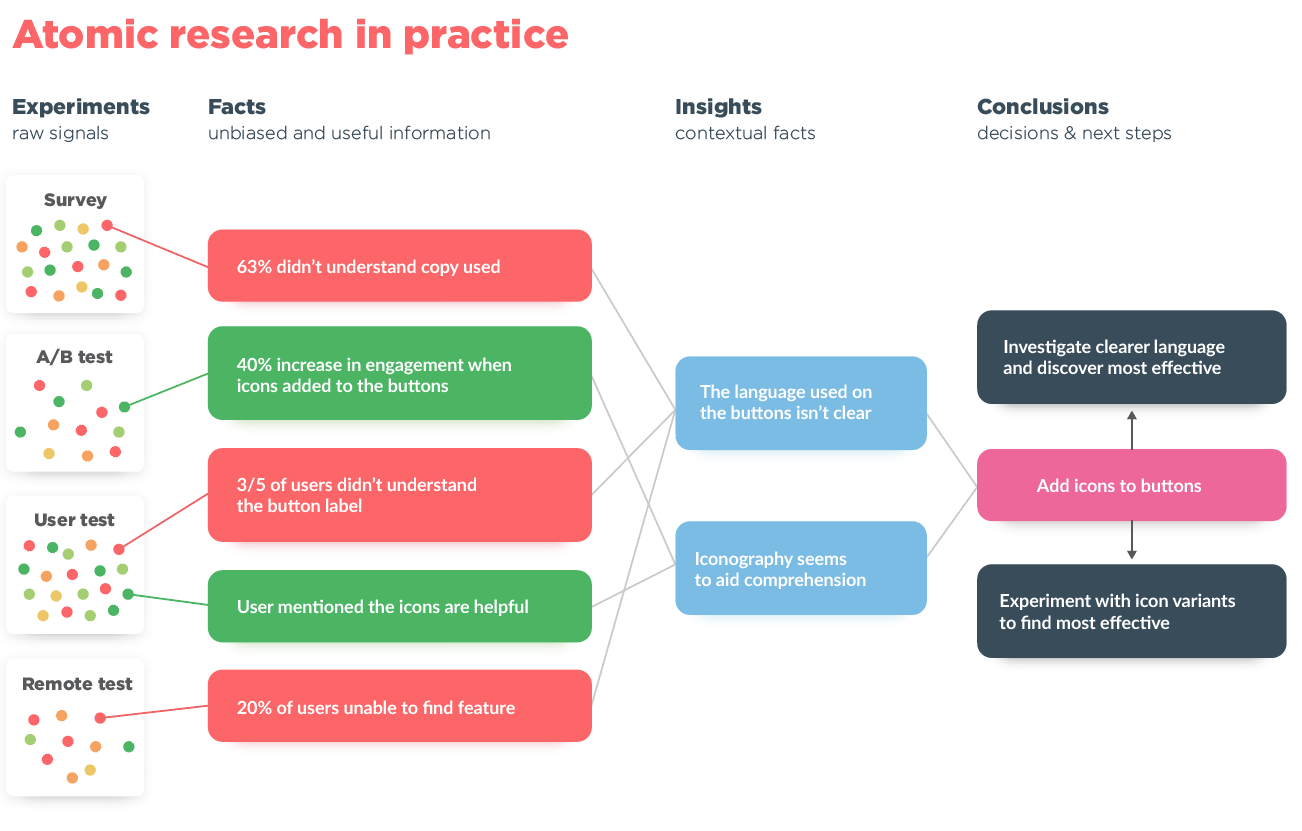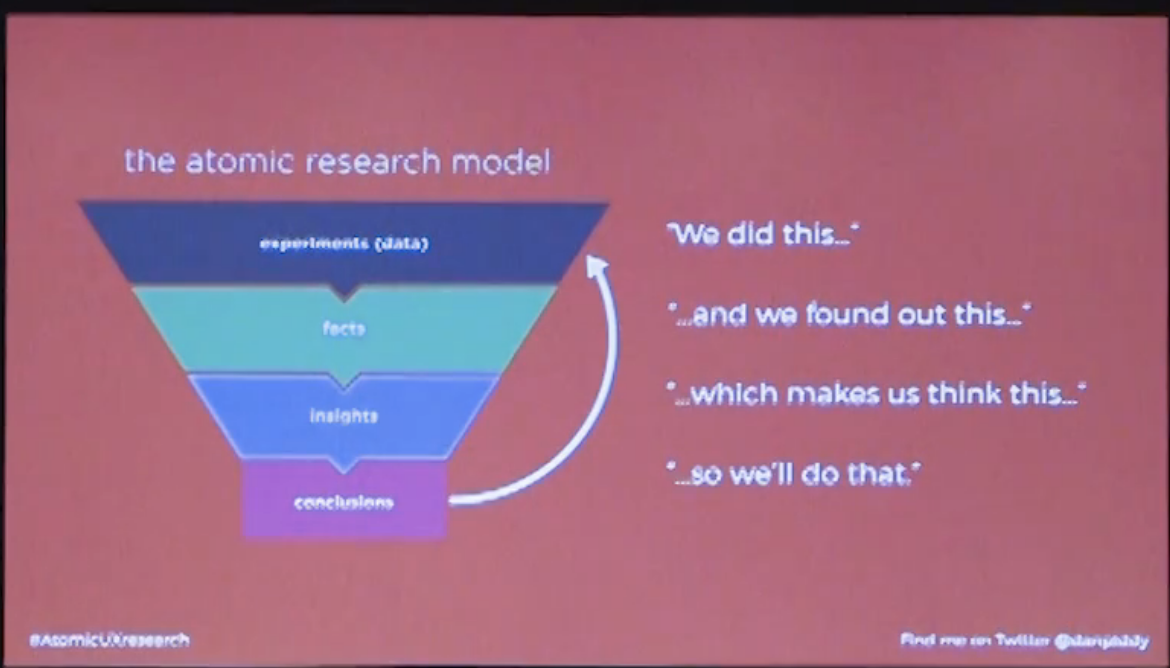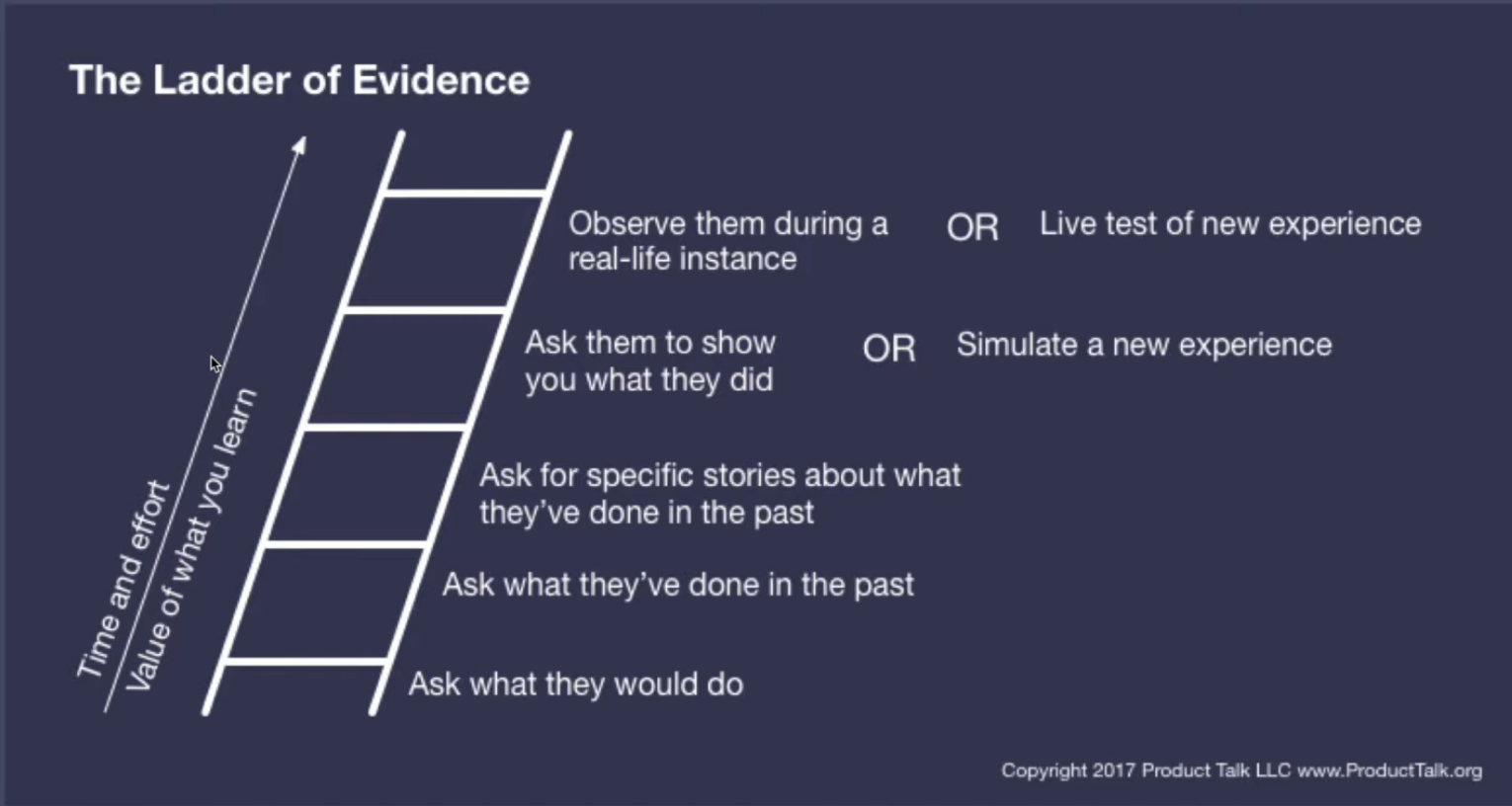Continuous Interviewing extract from CDH insights
Argumentation for continuous interviewing
This isn’t a linear process. You don’t map the opportunity space, choose a target opportunity, generate solutions, build something and then start over. All of these activities need to be happening in parallel. You want to stay open to the fact that you might have missed opportunities, that you might have chosen the wrong opportunity. Keeping an interview on the books each week helps to catch those mistakes. It also helps you develop a continuous mindset, rather than a waterfall mindset.
“Tell me about your recent decision to discontinue use of the product.” You’ll probably need to preface this with, please don’t hesitate to share negative feedback with us
If you need to change course and you’ve stopped interviewing, you’ll have to start from scratch. Your next steps will be delayed until you can ramp up interviewing again. 1
Every week that you don’t interview increases the chances that you’ll stop interviewing altogether. To nurture your interviewing habit, interview at least one customer every week.
… More importantly, continuous interviewing will help to ensure that you can get fast answers to your daily questions. 2
Important arguments to consider
‘it’s really time intensive’:
- create interview snapshots right after each interview
‘we don’t have enough people to derive themes after just a week’: Abandon the idea of themes. There are two units of synthesis:
- Synthesize what you are hearing in each interview. That’s the goal of the snapshot.
- Synthesize what you are learning across interviews by moving relevant opportunities to your OST.
‘When / how do we share these findings with others?’
- user interview snapshots and e.g. share in product trio sessions. “Each week we share the interview snapshots in our slack channel for everyone (including our stakeholders) to follow along.”
- extend the OST with interview insights
About automating
blocking a morning/afternoon for discovery interviews makes it easy to protect/commit to the time and makes it easy for support/customer-facing teams to help recruit/schedule. if you have the luxury of a ux research/coordinator they can help set-up/modify calendly self-scheduling pages with screening criteria or to help route the right customers to the right teams based on the opportunities they’re trying to learn most about
Success using Calendly for interviews. It eliminates a lot of the scheduling pain especially wrt time zone coordination. Their free plan includes one ‘meeting type’
combined firebase remote config with typeform with calendly to create a survey that I can change out at any time. Here is what I’m trying currently:
- Here’s the typeform: https://livetranscribe.typeform.com/to/NtpMxbYF
- It feeds data right into a calendly using this format: https://calendly.com/name/20min?name=@name?&email=@email?&a1=@phonenumber?&a2=@id
One of the biggest takeaways is always get the phone number and text them. Most people forget but are still free for the time you’d interview them, or will reschedule.
Use the power of user experience maps. As I interview more I find making a more and more detailed user experience map let’s me better dive into the details during the interview.
Embed in the app and lead them to directly book a slot in your calendar. Connect with e.g. Customer Support 3:
- If a customer calls to cancel their subscription, schedule an interview.
- If a customer has a question about feature x, schedule an interview.
- If a customer requests a customization, schedule an interview.
Tips for building the Continuous Interviewing habit
- There is a lot of research that says that one of the best ways to help you build a habit is to start tracking that habit.
- Share regularly with your stakeholders
Tuning the Show Up rate and reduce No Shows
$40 for 40 minutes
- Video: Show a brief video of yourself at the time of booking, so they feel they know who they are meeting with. Adds personalization + guilt if they choose to ghost you.
-
Time Gap: Reduce time gap between time of booking & interview slot. I’m considering adding a few same-day or next-day slots.
- Reduce the time between when they schedule and when they do the interview. Schedule same day, next day, or 2 or 3 days out, not weeks out. Humans are optimistic about how much time we’ll have in the future. We have a much better judge of how much time we have now.
- Provide a really clear overview of what will happen in the interview. For example, “We’ll have a casual conversation where I’ll ask you things like: Tell me about a time when …” Humans are afraid of the unknown. Remove the unknowns and you’ll see your no show rate go down.
- Ask for less time. 40 mins. is an odd time block. Ask for 30, or even 25. Make it an easier yes.
- Last, I would play with compensation. But unless you are way off, this is rarely the issue.
One of the benefits of story-based interviewing (assuming that’s what you are doing) is that participants really enjoy it. So you can highlight that.
I’ve found that if you limit the calendar to book either same day or at most the next day or two, you’ll get fewer no shows. (We are much more realistic about our time in the near term.)
Atomic UX research and building a research repository

https://www.youtube.com/watch?v=h9s3DrImGXA


Some learnings about Questions

more details are available with The Ladder of Evidence
Asking all the right questions - https://www.youtube.com/watch?v=PNQWNDZE5W8 - James Pyle
- listen like crazy
- you got to know how to ask questions
- start to talk about something … it takes time to get something relatable. And consider food, as this is something that all people have in common
- Ask what else and then what else and don’t drill down on a topic immediately. This enables to get a wider view first.
- 📖 [[Find Out Anything From Anyone Anytime - James O Pyle Maryann Karinch]]
- Who, What, When, Where and Why - Who else, What else, Why else as follow up
- 📖 [[A Curious Mind - Brian Grazer Charles Fishman]]
- let down the guard
- 4 things to talk about - people, places, things and events in time
What if your customer is asking for specific solutions during the interview? Let them describe what they’re looking for and then ask them 2 follow up questions:
1) if you had that what would that do for you? This reveals the unmet need—save them time, make them more strategic, etc.
2) if they have a substitute, can you show me how you use that today? This reveals the context in which they imagine using the solution they just described.
Advice for finding Non-Customers for interviewing in B2B
- run LinkedIn ads
- do outreaches on LinkedIn
- run landing pages and redirect traffic through ads onto them
- partner with outbound
- user recruiting platforms like userinterviews.com
- ask existing customers for intros
Tooling
- Ethnio and Intercom
- had success using Hotjar to survey/recruit participants but something like ethn.io offers an all in one solution.
- Sleeknote
- Tool https://glean.ly/
- Reconsider Airtable for building a research database - https://www.youtube.com/watch?v=VfwwpS4Jc98
- Also consider Dovetail for building the research repository
- compare to Aurelius, UserBit, Reveall, EnjoyHQ, Avrio, Condens
- User Research Repository with Miro - https://www.youtube.com/watch?v=0T4Rrr3zyRw
- Quality survey and interview sites.
- Respondent.io and UserInterviews.com
- testingtime.com
- Pollfish
- Grain.co and Fathom.Video both of these are great for user interviews and sharing insights
- The Mom Test by Rob Fitzpatrick
- Userlytics - for unmoderated testing
Linking
-
Torres, Teresa. Continuous Discovery Habits: Discover Products that Create Customer Value and Business Value (S.88). Product Talk LLC. Kindle-Version. ↩
-
Torres, Teresa. Continuous Discovery Habits: Discover Products that Create Customer Value and Business Value (S.94). Product Talk LLC. Kindle-Version. ↩
-
Torres, Teresa. Continuous Discovery Habits: Discover Products that Create Customer Value and Business Value (S.90-91). Product Talk LLC. Kindle-Version. ↩